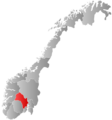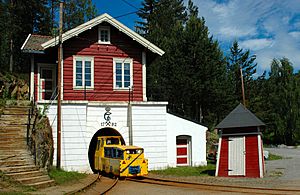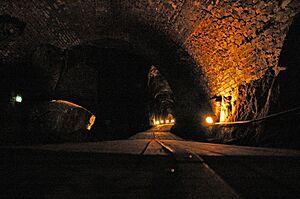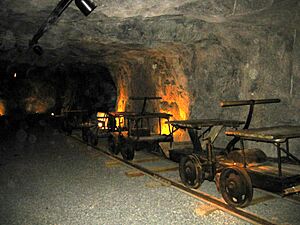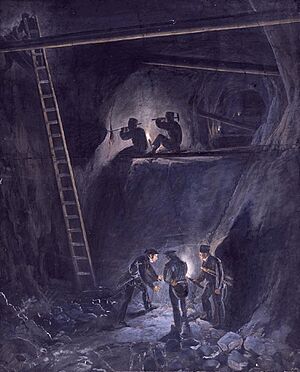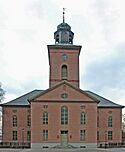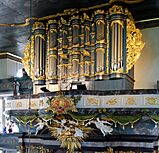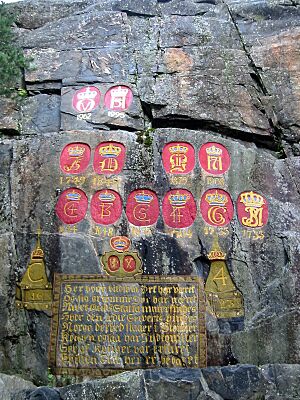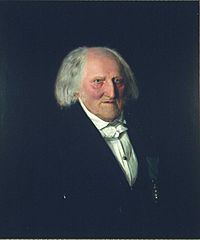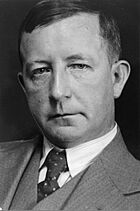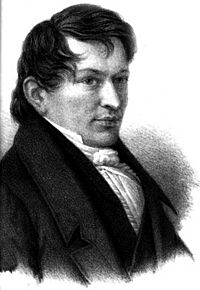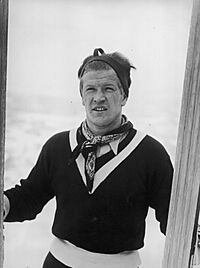Kongsberg facts for kids
Quick facts for kids
Kongsberg kommune
|
|||
|---|---|---|---|
|
Municipality
|
|||
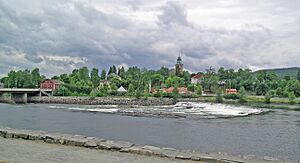
Kongsberg in July 2006
|
|||
|
|||
| Nickname(s):
Teknologibyen
The City of Technology |
|||
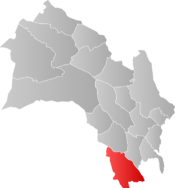
Kongsberg within Buskerud
|
|||
| Country | Norway | ||
| County | Buskerud | ||
| District | Lower Buskerud | ||
| Administrative centre | Kongsberg | ||
| Area | |||
| • Total | 792 km2 (306 sq mi) | ||
| • Land | 753 km2 (291 sq mi) | ||
| Area rank | #138s in Norway | ||
| Population
(2011)
|
|||
| • Total | 25,090 | ||
| • Rank | #27 in Norway | ||
| • Density | 31.2/km2 (81/sq mi) | ||
| • Change (10 years) | 8.9% | ||
| Demonym(s) | Kongsbering/ Kongsbergenser Kongsbergensar |
||
| Time zone | UTC+01:00 (CET) | ||
| • Summer (DST) | UTC+02:00 (CEST) | ||
| ISO 3166 code | NO-3303 | ||
| Official language form | Bokmål | ||
| Website | |||
|
|
|||
Kongsberg (pronounced KONG-s-berg) is a historic mining town and municipality in Buskerud county, Norway. It sits on the Numedalslågen river. Kongsberg is known for its long history of silver mining and making weapons. Today, it's a hub for high-tech industries. It is also home to the main office of Norway's largest defense company, Kongsberg Gruppen.
Kongsberg means "King's Mountain." King Christian IV of Denmark and Norway founded the city in 1624. This happened after silver was discovered there. The King invited skilled German engineers to help set up the Kongsberg Silver Mines. Many German immigrants came to live and work in Kongsberg. They brought their mining traditions and even spoke German in the mines.
By the 1700s, Kongsberg was Norway's second-largest city, after Bergen. It was a special mining city with its own rules. The Kongsberg Silver Mines closed in 1958 after 334 years. Now, it's a popular museum and a major tourist spot. Kongsberg is still home to the Royal Norwegian Mint, which makes Norwegian coins. It also makes coins for other countries.
Kongsberg is also home to Kongsberg Gruppen. This major Norwegian defence contractor was started in 1814. They made famous products like the Kongsberg Colt and the Krag–Jørgensen rifle. The University of South-Eastern Norway has a campus in Kongsberg. There is also Tinius Olsen's school, which is a technical college and high school.
Contents
History of Kongsberg
Kongsberg was founded as a mining community in 1624. This happened after silver was found there. The town and the Kongsberg Silver Mines started in its second year. Records say that shepherds' children found the silver in 1623. But there were signs that silver had been mined before.
Kongsberg became Norway's biggest industrial center before the Industrial Revolution. At its peak in the early 1700s, the silver mines helped the country's economy a lot. King Christian IV brought German miners from Saxony and Harz. They shared their mining skills, which was very important.
Most of the workers were German in the early years. But over time, more Norwegians joined the workforce. By 1648, there were more Norwegian workers than German. Gunpowder was first used in mining in 1681. The mines needed a lot of energy. So, they built a large artificial dam to power the mine's lifts.
A road was built from Hokksund to Kongsberg in 1624. This road was important for the silver mines. It was the most important road built in Norway in the 1600s. The mining industry became very important to the state. The German miners also brought their own legal system and a special miners' association. This group offered medical help, pensions, and sick leave.
The silver from Kongsberg helped Denmark–Norway pay for wars. Precious metals were also important for money. So, the Royal Mint moved to Kongsberg in 1686. Kongsberg was known for its very pure silver. The ore also had small amounts of gold, copper, and cobalt. About 15,750 tons of silver were taken out of the mines. This happened between 1623 and 1957.
By 1769, about 4,000 people worked in the mines. The town had 8,000 people in total. This made it the second largest town in Norway. Kongsberg got its official town status in 1802. After some tough years for the mines, a defense industry was started in 1814.
The Royal Norwegian Mint is still in Kongsberg. It was started in 1686. Kongsberg was also home to the Kongsberg School of Mines. This school taught mining technology from 1757 to 1814.
Over time, the defense industry grew into many other high-tech businesses. These now provide most of the jobs in Kongsberg. In 1987, the state-owned Kongsberg Weapons Factory faced problems. It was then split into smaller companies. Today, these companies are a major high-tech group in Norway. They focus on defense and sea-related technology.
Coat-of-arms
The coat-of-arms for Kongsberg was designed by Hallvard Trætteberg. It was approved on August 25, 1972. The design comes from the city's old seal from 1689. This old seal shows the Roman god Janus. He is dressed like an emperor, representing the king.
The sword and the scales show justice. The green color stands for the forests. Silver represents the mountains. Gold stands for wealth.
Geography
Kongsberg is located at the start of the Numedal valley. Further south, the valley is called Lågendalen.
Kongsberg is surrounded by other towns. These include Flesberg to the north and Øvre Eiker to the east. The town is divided by the Numedalslågen river. This river has three waterfalls right in the town.
Climate
Kongsberg has a humid continental climate. This means it has warm summers and cold, snowy winters. The wettest time of year is late summer and autumn. February to April are usually the driest months.
Kongsberg can get quite warm in summer. The highest temperature ever recorded was 34.6°C in June 1970. In winter, it gets colder than Oslo. Snow is very common on the ground. The most snow ever recorded was 123 cm in March 2006. The lowest temperature ever was -32.5°C in January 1941.
Transportation
The main roads in Kongsberg are the E134 and Norwegian national road 40. The E134 goes east to west. It connects to the E18 to Oslo. Road 40 goes north to south.
The Sørland Line train stops at Kongsberg Rail Station. From there, you can connect to local and regional buses.
Culture
As the town grew, a new church was needed. Kongsberg Church was built over 21 years and opened in 1761. It has a simple red brick outside. But inside, it's beautifully decorated in a baroque style. It has unique chandeliers made nearby. Kongsberg Church is one of Norway's largest. It can seat 2,400 people.
The church has a very old pipe organ. It was made by a famous German builder in 1760–65. This organ was fully fixed up in 1999–2000. It is the largest baroque organ in Scandinavia. Every January, the Gloger Music Festival is held here. It brings artists and music lovers from around the world.
Since 1964, Kongsberg has hosted the Kongsberg Jazzfestival. This is an international jazz festival held every year. Big names like B. B. King and Diana Krall have played there.
Sport
Kongsberg is famous for its many great ski jumpers. Birger Ruud and his brothers won many medals in the 1930s and 1940s. The first ski jumping style, the Kongsberger technique, was developed here. It was the most popular style from the 1920s to the 1950s.
You can see their medals and equipment at the Kongsberg Skiing Museum. This museum is in the same building as the Norwegian Mining Museum. Hjalmar Hvam, who invented the modern ski binding, was born in Kongsberg.
Recent winter sports stars from Kongsberg include Olympic snowboarders Stine Brun Kjeldaas and Silje Norendal. There is a large ski center for alpine skiing and snowboarding. It has been open and growing since 1965. Kongsberg also hosted parts of the 2006 Nordic skiing National Championships.
The local basketball team, Kongsberg Miners, is one of the best in Norway. The 1978 World Orienteering Championships were held in Kongsberg. Motorcycle speedway has also been popular in Kongsberg.
The Crowns in Håvet
This attraction is called Kronene i Håvet, which means "The Crowns in the Hollow." It's a place where Norwegian royal symbols are carved into the mountainside. This marks royal visits to the city. King Frederik IV visited in 1704 and started this tradition. He also made sure earlier kings' symbols were carved.
The first symbol was for Christian IV, who founded Kongsberg in 1624. Other kings who visited and have their symbols carved include Frederik III (1648) and Christian V (1685). More recent kings like Haakon VII (1908), Olav V (1962), and Harald V (1995) also have their symbols there.
Kongsberg Technology Park
Kongsberg Technology Park is a major business area in Kongsberg. It has over 5,200 employees from many different countries. Its history goes back to 1814.
Many important companies are located here. These include Kongsberg Gruppen, Kongsberg Defence & Aerospace, GKN Aerospace, and Siemens Energy. The park also manages properties in other Norwegian towns.
Notable residents
Public Service & Public Thinking
- Christian Peder Bianco Boeck (1798–1877) – a doctor and scientist who studied animals and plants.
- Erik Brofoss (1908–1979) – an economist and politician.
- Morten Thrane Esmark (1801–1882) – a priest and mineralogist, who helped discover the element Thorium.
- Sverre Fehn (1924–2009) – a famous architect and professor.
- Tinius Olsen (1845–1932) – an Norwegian-American engineer and inventor.
- Ole Petter Ottersen (born 1955) – a professor of medicine and former head of the University of Oslo.
- Thoralf Skolem (1887–1963) – a professor of mathematics.
- Poul Steenstrup (1772–1864) – an industrial leader.
The Arts
- Tine Asmundsen (born 1963) – a Norwegian jazz bassist.
- Håkon Austbø (born 1948) – a classical pianist.
- Halfdan Cleve (1879–1951) – a classical composer.
- Ivar Grydeland (born 1976) – a jazz guitarist.
- Maurits Hansen (1794–1842) – a journalist and novelist.
- Morten Harket (born 1959) – the lead singer of the band a-ha.
- Morten Qvenild (born 1978) – a jazz pianist and band leader.
- Christian Sinding (1856–1941) – a composer and pianist.
Sport
- Hans Beck (1911–1996) – a ski jumper who won a silver medal at the 1932 Winter Olympics.
- Ailo Gaup (born 1979) – a former freestyle motocross rider and world champion.
- Petter Hugsted (1921–2000) – a ski jumper who won a gold medal at the 1948 Winter Olympics.
- Hjalmar Hvam (1902–1996) – a Nordic skier who invented the first safety ski binding.
- Silje Norendal (born 1993) – a snowboarder and gold medalist in Winter X Games.
- Birger Ruud (1911–1998) – a ski jumper who won gold medals at the 1932 and 1936 Winter Olympics.
- Sigmund Ruud (1907–1994) – a ski jumper who won a silver medal at the 1928 Winter Olympics.
- Daniel-André Tande (born 1994) – a ski jumper and team gold medalist at the 2018 Winter Olympics.
Twin towns – sister cities
Kongsberg is twinned with these cities:
 Chitose, Japan
Chitose, Japan Espoo, Finland
Espoo, Finland Gouda, Netherlands
Gouda, Netherlands Køge, Denmark
Køge, Denmark Kristianstad, Sweden
Kristianstad, Sweden
Gallery
See also
 In Spanish: Kongsberg para niños
In Spanish: Kongsberg para niños



